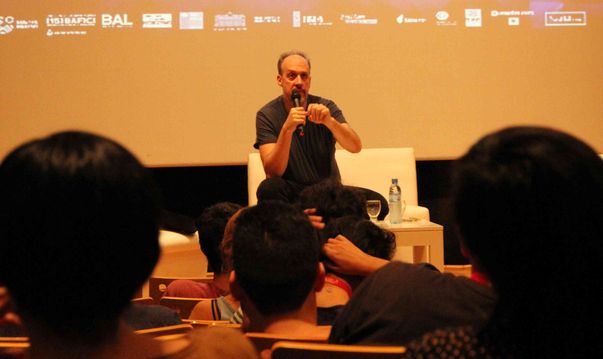Kind Words From A Strict Thinker
Santiago Gonzalez Cragnolino of the 2013 Talent Press Buenos Aires saw a lecture of legendary film critic and programmer Kent Jones at the Talent Campus Buenos Aires.

Kent Jones at his lecture How To Understand Contemporary Cinema.
Assistants to Talent Campus Buenos Aires 2013 had the opportunity of participating in a lecture given by Kent Jones titled How To Understand Contemporary Cinema. For those who do not know Jones, he is one of the most important critics of the last fifteen years, who has also become a filmmaker and a New York Film Festival programmer. He is one of the voices that stand out in the choir of opinions and comments of that ever changing, fragile and almost impossible to grasp category known as contemporary cinema.
As economic in his speech as he is when writing or filming, Jones' exposition revealed his inclination to be concise and leave out anything superfluous that he could not support with concrete examples or that he could not call by its name. Jones gave a kind lecture, nonetheless answered with rigor when having to illustrate his arguments.
The content of the exposition offered to Talent Campus' assistants was centered in the changes surfacing in filmmaking because of technological advances. Faced with the possibility of cinema being in a period of transition, not even the smartest or sharpest analyst is exempt of experiencing uncertainty towards the future. Thus, when having to describe the current state of cinema and talk about the possible advantages and disadvantages of the use of the new technological devices filmmakers have access to, Jones' position was a moderate one. He pointed out that what is produced today with the traditional devices is neither better nor worse than what is produced, for example, with technologies which facilitate image postproduction on set. Jones however stated that the not so soft transition from analog to digital formats still echoes in the spectator's mind. To support this idea, Jones mentioned how often image postproduction effects are used to give the impression that what is shown on the screen comes from a film roll rather than from a digital image. This interesting contradiction is something worth considering.
Moving on to more uncertain territory, Jones mentioned two tendencies in contemporary cinema that he believes are in the process of growing. On the one hand, cinema could develop into a collection of films filled with visual and sound elements guided by mass entertainment. On the other hand, the other tendency, triggered by a more democratic access to recording devices, could result in smaller and simpler productions, destined to a group of connoisseurs with limited formal possibilities: a small-scale auteur-driven cinema. The problem with this, Jones stated, is that these movements will not be able to establish a dialogue, which will result in the decay of film as an art, which traditionally benefits from the clash between industrial and independent film perspectives.
Finally, Jones celebrated the existence of films schools. He considered that what is taught is valuable, and for that reason they will continue existing. Unlike what happened with past generations such as "the music video generation", which helped establish the audiovisual formula where "the cut is not important", the new generations of film students have the possibility of learning the value of the medium, its tools and the importance of making use of the formal devices for a personal aesthetic search rather than arbitrarily. In that sense, he valued the opportunity film schools offer to those who take an interest in the seventh art to express through the language of film their views of the world, and to share it through motion pictures, beyond any screening formats or tools that allow these to appear on the screen.

